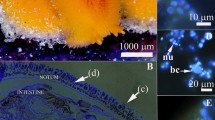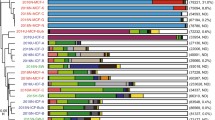Abstract
Female cuttlefish harbour a dense bacterial community in their accessory nidamental glands (ANG), as is also the case for the myopsid squids. Molecular approaches have been applied to explore this symbiotic association in the sepiid species Sepia officinalis. In situ localisation by Bacteria-specific probes in tissue sections of the ANG revealed the presence of a dense bacterial population in the lumina of the organ tubules. The phylogenetic identification of bacterial strains was realised by 16S rRNA gene sequencing analysis. None of the sequences obtained matched perfectly with known sequences in the database. However their similarity percentages allowed us to relate them to various bacterial groups including the taxa Agrobacterium, Roseobacter, Sporichthya, Rhodobium–Xanthobacter and Clostridium. Some bacterial species are common to both sepioids and myopsid teuthoids, others are different.
Similar content being viewed by others
Author information
Authors and Affiliations
Additional information
Received: 28 May 1999 / Accepted: 2 November 1999
Rights and permissions
About this article
Cite this article
Grigioni, S., Boucher-Rodoni, R., Demarta, A. et al. Phylogenetic characterisation of bacterial symbionts in the accessory nidamental glands of the sepioid Sepia officinalis (Cephalopoda: Decapoda). Marine Biology 136, 217–222 (2000). https://doi.org/10.1007/s002270050679
Issue Date:
DOI: https://doi.org/10.1007/s002270050679




